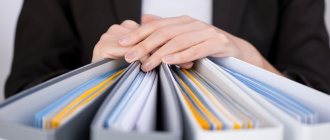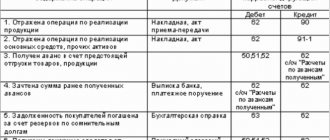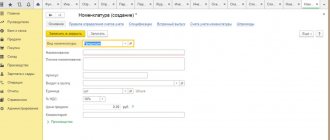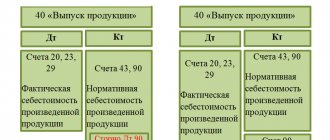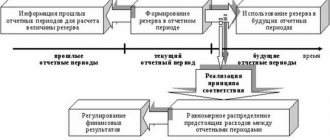Work in progress: reflected in reporting
The cost of production costs not written off to the cost of finished products (work performed, services) is recognized as the cost of work in progress.
Work in progress is reflected in the balance sheet asset in the 2nd section “Current assets” in the line “Inventories”, being part of the amount of all inventories available at the reporting date. Read more about the structure of the balance sheet in the article “Balance sheet (assets and liabilities, sections, types)” .
You will find information on the procedure for filling out a balance sheet in this material .
You will learn how to fill out a balance sheet for “simplified” people by reading the material “How to fill out a balance sheet under the simplified tax system?” .
Reflection of main production in the balance sheet
The main production in the balance sheet should be recorded in line 1210, after the enterprise accumulates debit balances of the 20th account at the end of the reporting period. The article will discuss the intricacies of the procedure for reflecting information in this report.
Contents The balance sheet is the main accounting reporting tool for organizations. Using this form, the state of the finances and economy of the enterprise is reflected at the reporting date.
The balance sheet includes the balances formed on all accounting accounts by this time. These balances are collected into groups according to pre-designated characteristics, and then entered into the report lines intended for this. To reflect data on the account intended for main production, you should go to the balance sheet asset.
In this part of the form, in the section “Current assets” (2nd section) in the inventory line, data is recorded, but not separately, but as an integral part of all inventories formed as of the reporting date.
Work in progress: accounting account
Costs in work in progress are taken into account in production cost accounts: 20 “Main production”, 23 “Auxiliary production”, 29 “Service production and facilities”. But the answer to the question whether the costs of work in progress in accounting will be formed taking into account the costs accumulated in accounts 25 “General production expenses” and account 26 “General expenses” depends on what the organization has written down in its accounting policy.
Costs collected on account 25 for the month can be fully attributed to the main production cost account (20), or can be distributed either to 2 accounts (20 and 23) or to all 3 direct cost accounts (20, 23, 29) . The expenses accumulated on account 25, together with direct costs, form the production cost of products, works or services.
Account 26 can be distributed similarly to account 25 (then the full cost will be collected on the corresponding accounts), or you can write off the entire amount collected on it every month to the financial result (to the debit of account 90). In the latter case, the cost of a specific product (work, service) will not include its data.
Read more about account 20 in the material “Account 20 in accounting nuances).”
Accounting for production costs (account 20)
Now let's talk about exactly what costs are taken into account as the debit of account 20, and what entries are reflected in accounting.
- Direct costs, that is, those that are directly related to the production process. This could be the wages of employees (entry D20 K70 ), materials used in production (entry D20 K10 ), depreciation of fixed assets involved in the production process (entry D20 K02 ), social contributions from personnel salaries (entry D20 K69 ).
- Auxiliary production costs. An example of an auxiliary production could be a company’s own boiler room; the costs of its maintenance are taken into account in the debit of the account. 23 “Auxiliary production”, then the amount of all these costs is written off to the debit of the account. 20 “Main production” (posting D20 K23 ).
- Indirect costs, that is, those associated with the management and maintenance of production, are written off from the credit of accounts 25 “General production expenses” and 26 “General expenses” (entries D20 K25 and D20 K26 ).
- Defects in production are products, parts and work that do not meet established quality standards and cannot be used for their intended purpose. We’ll talk more about manufacturing defects in this article. For now, I’ll just say that defects are taken into account in account 28 “Defects in production” and written off as a debit to the account. 20 “Main production” (posting D20 K28 ).
Accounts 23 “Auxiliary production”, 25 “General production expenses”, 26 “General expenses” are not always used by the enterprise. These are intermediate, auxiliary accounts; they are convenient to use in large production. If the company has a small production, then there is no point in entering additional accounts; all costs can be taken into account immediately on the account. 20.
Thus, it was determined that according to the debit of the account. 20, all costs associated with the main production are taken into account, that is, the cost of finished products is formed.
This cost is then written off from the credit account. 20 to the debit of the account. 40, 43 or 90.
If the cost of finished products is taken into account at standard (planned) cost, then all expenses from the credit account. 20 are debited to the account. 40 “Release of products, works, services” (posting D40 K20 ).
If the cost of finished products is taken into account at the actual (production) cost, then all expenses from the credit of account 20 are written off to the debit of account 43 “Finished products” (entry D43 K20 ).
Products can also be immediately sent for sale, bypassing product accounting accounts, then posting D90/2 K20 .
At the end of the month, account 20 “Main production” is closed, the balance on account 20 reflects the value of work in progress, this balance is transferred to the beginning of the next month.
To reinforce the above information, I suggest looking at a couple of examples.
Composition of main production costs
Account 20 is used to account for direct and indirect expenses incurred in connection with:
- with the production of products of any kind;
- provision of all types of services;
- performing construction and contracting, design, survey and geological exploration work;
- carrying out repair work;
- carrying out design and research work, etc.
Direct expenses are written off to the debit of the “Main production” account from the credit of the accounts:
- 02 and 05 - regarding depreciation of property used for main production
- 10, 15, 16, 21 - for used inventories and costs associated with their acquisition;
- 60 and 76 - for production services directly related to the main production;
- 69 and 70 - regarding the salaries of the main production personnel and charges for it.
Defects subject to correction are also written off for the main production (Dt 20 Kt 28). Every month, from the credit of account 23 to account 20, part of the costs of auxiliary production is received, from the credit of account 25 - indirect costs (or part thereof) to ensure production, from the credit of account 26 - part of general business expenses (if the organization does not use the direct costing method and does not write off these expenses are debited to account 90).
Cost accounting for main production: general principles
The costs of main production for enterprises of any form of ownership and any type of activity are expenses associated with the main activity.
The first goal of business enterprises is to make a profit. This goal is achieved through the performance of specific functions (production, provision of services). These are the costs for performing these main functions and are reflected in account 20 “Main production”. Let us recall that in trading enterprises, costs associated with core activities can be reflected in account 44 - “Distribution costs”.
What are these expenses? In the debit of the 20th account, material costs, expenses for wages and social insurance of personnel of the main production are allocated to the expenses of the main production. It also reflects the depreciation of production equipment and other objects used for the same purposes (real estate, engineering structures related to production workshops). Here the cost of fixed assets less than 40,000 rubles is included in expenses. (clause 5 of PBU 6/01).
For more information on how to calculate depreciation, see the article: “Calculation of depreciation of fixed assets in 2016.”
The listed expenses form the direct production costs of the enterprise. Indirect costs are formed on the 25th and 26th accounts.
Note that the expenses of auxiliary production related to production costs are distributed proportionally to the expenses of the main production. Part of the costs on the credit of account 23, written off to the debit of account 20, also forms expenses for the main production of the enterprise.
Formation of the balance of work in progress
The actual cost of manufactured products (works, services) is written off from the credit of the “Main production” account. In this case, account 20, depending on the adopted accounting policy, corresponds with accounts 40, 43, 90.
The balance of account 20 remaining at the end of the month reflects the value of the main work in progress (WIP).
Balances on accounts 23 “Auxiliary production” and 29 “Service farms” are formed in a similar way. Accordingly, the balance on account 23 shows the cost of auxiliary work in progress, and the balance on account 29 shows the cost of work in progress at service farms.
The balance of work in progress in accounts 20, 23, 29 is the balance of work in progress in accounting for the organization as a whole. Work in progress - account 20 + account 23 + account 29, not closed at the end of the reporting period - the balances on them are summed up with other data entered in the “Inventories” line in the balance sheet.
The procedure for filling out a balance with a breakdown of accounts is discussed in detail in the Guide from ConsultantPlus. Get free trial access to the system and study the material.
Does not apply to work in progress:
- raw materials, supplies, purchased finished products transferred to workshops (sites), but not processed;
- rejected semi-finished products that cannot be corrected.
Read about the entries that arise when accounting for irreparable defects in the article “Accounting for defects in production - accounting entries.”
Direct and indirect costs
Features of accounting for costs related to work in progress are determined by industry guidelines, since they quite strongly depend on the specifics of the type of specific production.
There is no clear list of costs that should be classified as direct in the law on accounting and other regulatory materials. There is only a mention in the Instructions for using the chart of accounts, approved by Order of the Ministry of Finance dated October 31, 2000 No. 94n, that direct costs should include the cost of inventory and the cost of paying workers involved in the production process.
Such uncertainty in regulations indicates that the enterprise, in accordance with the characteristics of its production, should reflect in its own accounting policies which costs for accounting purposes will be classified as direct and which as indirect.
Direct costs include:
- material costs for production (raw materials, materials, semi-finished products and components);
- expenses for remuneration of personnel involved in production and maintenance of the production process;
- expenses for compulsory pension, social and medical insurance accrued for the remuneration of the above-mentioned personnel;
- depreciation charges for fixed assets used in the production process.
For methods for valuing inventories written off for production, read the material “Methods for valuing inventories .
Then all other expenses will be indirect.
To learn how to divide production costs into direct and indirect for income tax purposes, read the article “How to divide income tax expenses into direct and indirect?” .
Work in progress in accounting
In accordance with paragraph 63 of the PBU on accounting and accounting, approved by Order of the Ministry of Finance dated July 29, 1998 No. 34n, products or services (work) that have not completed all phases of the production cycle should be classified as work in progress (work in progress). This also includes products that are understaffed and/or have not passed testing and technical acceptance.
As stated in paragraph 64 of the PBU on accounting and accounting, for reflection in the balance sheet, the assessment of work in progress can be carried out according to:
- actual production cost;
- standard (planned) production cost;
- cost of material costs (raw materials, materials and semi-finished products);
- the amount of direct costs.
Those enterprises that have established serial or mass production can choose one of the indicated methods for assessing work in progress. And those manufacturers who produce products in single copies should show work in progress only based on actual costs incurred.
The chosen method of assessing work in progress must be fixed in the accounting policy. When choosing a method for estimating work in progress using direct cost items, it is recommended that the accounting policy reflect how the organization will distribute current expenses and work in progress balances at the beginning of the month between the release of finished goods and work in progress at the end of the month.
From 2021, the procedure for assessing work in progress is determined by the new FSBU 5/2019 “Inventories”. It is discussed in detail in the Ready-made solution from ConsultantPlus. Get trial access to the system for free and proceed to the material.
Results
The balance on the accounts “Main production”, “Auxiliary production”, “Service production and farms” at the end of the reporting period indicates that there is unfinished production. The cost characterizing work in progress at the end of the reporting period is taken into account in the data that forms the indicator of line 1210 of the “Inventories” balance sheet.
Account 20 takes into account direct production costs;
Every month, at the end of the month, part of the indirect expenses is included there, taking into account the peculiarities of their distribution established by the accounting policy. In addition, the accounting policy establishes the rules for dividing expenses into direct and indirect, the procedure for closing accounts for indirect expenses and assessing work in progress. You can find more complete information on the topic in ConsultantPlus. Free trial access to the system for 2 days.
Important features of account 20
Account 20 “Main production” has a number of distinctive features:
You can find more complete information on the topic in ConsultantPlus. Free trial access to the system for 2 days.
- Before closing account 20 - Main production - it is necessary to take an inventory of the balances of work in progress.
- The list of expenses related to the main production, the chosen method of closing account 20, the method of accounting for management expenses (at full or reduced cost), the distribution base when producing several types of products or accounting for work, services under different contracts - all these important accounting elements must be approved in accounting policy.
- Small enterprises have the right to maintain simplified accounting:
- integrated accounting of all production costs only on account 20, without using accounts 21, 23, 26, 29, 44;
- accounting for fixed assets and inventories in a special manner, without the formation of work in progress balances;
- write-off of expenses as current immediately into the cost of sales (information message of the Ministry of Finance dated June 24, 2016 No. IS-accounting-3).
